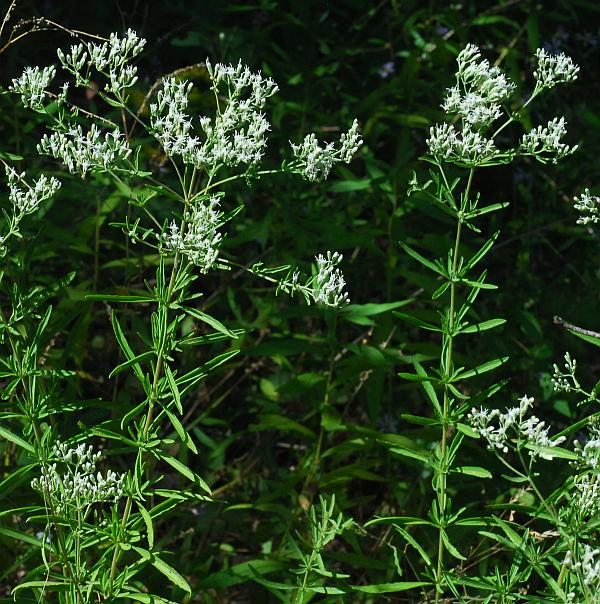Eupatorium hyssopifolium L.
Hyssop-Leaved Thoroughwort

Native
CC = 5
CW = 5
MOC = 8
© SRTurner
Eupatorium hyssopifolium L.Hyssop-Leaved Thoroughwort | |
 |
Native CC = 5 CW = 5 MOC = 8 |
© SRTurner |
|
Family - Asteraceae/Eupatorieae Habit - Fibrous rooted, rhizomatous perennial forb. Stems - Erect, to 1 m, moderately to densely short-hairy, not glaucous, with small axillary fascicles of leaves at all or most nodes, up to 1/2 as long as the main stem leaves.
Leaves - Mostly in whorls of 3-4, simple, sessile. Blades 1-6 cm long, 0.5-6.0 mm wide, linear to narrowly oblong-elliptic or oblanceolate, more or less tapered at the base, tapered to a sharply pointed tip, the margins entire or less commonly with a few shallow teeth, often revolute, the surfaces glabrous or sparsely to moderately short-hairy along the midvein, also densely gland-dotted, with 1 main vein.
Inflorescence - Terminal panicles of heads, usually flat-topped.
Heads - Discoid, containing 5 florets. Involucre 4-6 mm long, nearly cylindrical, the bracts lanceolate or narrowly oblong, mostly rounded or bluntly pointed at the tip, the margins thin and pale or transparent, faintly 1-or 3-nerved, densely short-hairy, green.
Flowers - Ray florets absent. Disk florets 5 per head, with corollas 3.5-4.0 mm, 5-lobed, often glandular, white. Styles exserted at anthesis. Pappus of capillary bristles.
Fruits - Achenes 2.5-3.5 mm long, 5-angled. Flowering - August - November. Habitat - Savannas, upland prairies, pond margins, fields, ditches, roadsides, dry, open, disturbed areas. Origin - Native to the U.S. Lookalikes - E. semiserratum. Other info. - This showy species is rare in Missouri, being found in a few counties mostly clustered in the eastern Ozark division. Beyond Missouri it occurs in scattered locations in the southeastern U.S., most commonly in coastal states. It has been slowly extending its range northward, possibly in response to a warming climate. The plant's inflorescences appear similar to those of other species of Eupatorium, but the whorls of narrow leaves with bundles of smaller leaves at the nodes is diagnostic for this species. Another rare species, E. semiserratum Willd. appears somwehat similar, but has wider leaves and lacks the axillary fascicles. E. hyssopifolium also has bigger, brighter flowers. Photographs taken in the Croatan National Forest, NC., 10-20-02 (DETenaglia); also at Taum Sauk State Park, Iron County, MO, 9-8-2014, and St. Joe State Park, St. Francois County, MO, 8-29-2019 (SRTurner). |